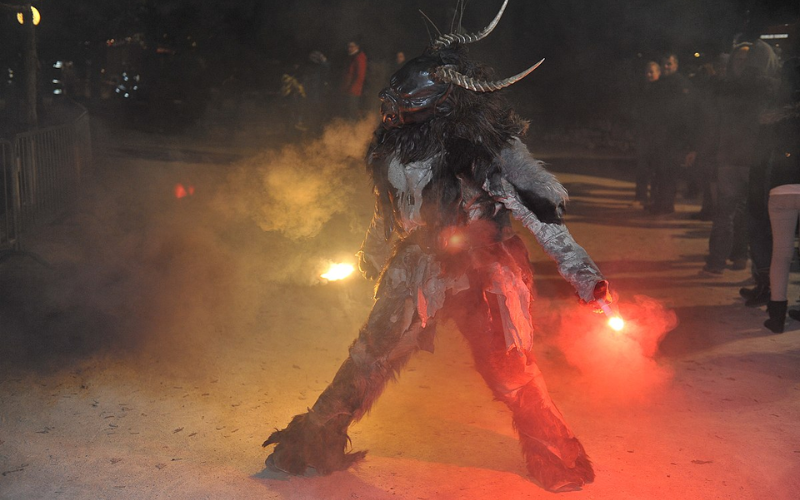Think Christmas is all about green trees and red baubles? Here are 5 unique Christmas traditions you didn’t know of.
{{ vm.tagsGroup }}
15 Dec 2021
5 Min Read
Tiffany Chan (Guest Contributor), Ailyn Low (Editor)
Think Christmas is all about green trees and red baubles? Here are 5 unique Christmas traditions you didn’t know of.
Christmas is one of the most widely celebrated holidays in the world. But while many of us associate the season with snowy landscapes and sparkling trees, certain countries have their own unique take on the celebration. Read on to learn about five strange Christmas traditions practiced around the world.
Austrians took ‘gotta find out who’s naughty and nice’ to a whole ’nother level. According to their tradition, children who make it onto the ‘naughty’ list will be punished by St. Nicholas’ (or Santa’s) evil counterpart, Krampus, a half-goat demon.
On Krampusnacht, December 5th, men dressed as Krampus parade in the streets, carrying chains and baskets that are meant for abducting bad children. Most of the time, these men would drink alcohol before setting out to terrorise kids.
But why the demons during such a lovely time as Christmas? This tradition actually originates from pre-Christian Eastern Europe beliefs and anthropologists speculate that Krampus was derived from a pagan deity who is likened to Satan. Today, many European countries celebrate Krampusnacht. While Christmas generally gives more good vibes, it does bring out the elements of good vs. evil which is pretty fitting for Christmas, isn’t it?
Regardless, it’s a good reminder to always put on your best behaviour, especially for the kids!
If you spot wispy white strands on Christmas trees in Ukraine, know that those aren’t fake snow, but cobwebs. The tradition of decorating trees with spider webs originates from the Ukrainian Legend of the Christmas Spider, which tells of a family who were so poor, they couldn’t afford to decorate their Christmas tree. Because of this, the night of Christmas Eve, when everyone was asleep, a magical spider covered their tree in cobwebs. The next morning, the family wakes up to find the cobwebs miraculously turned into silver and gold.
Tis’ the season to give back. Though it may not be the most common tradition worldwide, one thing we can resonate with is that Christmas isn’t just a season to give and receive gifts from loved one or people close and dear to us, but to also consider the less fortunate. Something you’d like to consider to do differently this Christmas. And perhaps you’d like to do what the Ukranians do while you’re at it?
Today, Ukrainians still create little Christmas ornaments in the shape of a spider (known as pavuchky or ‘little spiders’). Finding a real spider on a Christmas tree is also considered good luck. This does make me wonder, though: if Spiderman went to Ukraine during Christmastime, would he be treated like Santa Claus?
Similar to pumpkin carving during Halloween, Mexicans carve radishes on 23 December, also known as Noche de Rábanos (Night of the Radishes) in the city of Oaxaca. Radishes are specially grown for this occasion and can grow up to 50cm long, weighing up to 3kg.
So, why radishes? Some say that this tradition began when a few monks brought some extra large radishes to the Oaxaca Christmas market in the mid 1700s. Later in 1897, the mayor of Oaxaca City started the radish carving competition as a way of attracting more people to the Christmas market.
Fun fact: Back in the days, before pumpkins were associated with Halloween, radishes were also used!
All I want for Christmas is a new set of clothes… because if I don’t have one, the Yule Cat would come and eat me! According to an Icelandic traditional story, if you don’t wear new clothes on Christmas Day, the Jólakötturinn, or Yule Cat, will come and eat you. This story began as a way to motivate wool workers to work during autumn so that they’ll have enough wool for the frigid winter.
Besides new clothes, it’s tradition for most Icelanders to get each other a new book during Christmas. This custom is called Jolabokaflod or Jólabókaflóð, meaning ‘Christmas flood of books’. While I’m a firm believer of book-giving, regardless of the occasion, this tradition actually contains a deeper meaning. During World War II in Iceland, books were one of the few things that weren’t rationed. Hence, it became the most affordable kind of gift back then.
So, if you’re looking for a gift, consider gifting your favourite book and share this fun fact with them!
Though some of us may be scratching our heads at these traditions, one thing that we can all agree on is that the spirit of Christmas is about love, joy, and peace. These customs, strange as they may sound, ultimately bring people together as they celebrate the season in their own, special ways. Whether you’re carving an alligator-shaped radish or dressed up as a half-goat half-man demon, I wish you a...
Merry Christmas and a Happy New Year!


